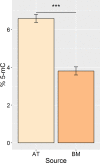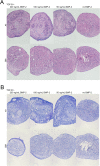Characterization and Immunomodulatory Effects of Canine Adipose Tissue- and Bone Marrow-Derived Mesenchymal Stromal Cells
- PMID: 27907211
- PMCID: PMC5131977
- DOI: 10.1371/journal.pone.0167442
Characterization and Immunomodulatory Effects of Canine Adipose Tissue- and Bone Marrow-Derived Mesenchymal Stromal Cells
Abstract
Background: Mesenchymal stromal cells (MSC) hold promise for both cell replacement and immune modulation strategies owing to their progenitor and non-progenitor functions, respectively. Characterization of MSC from different sources is an important and necessary step before clinical use of these cells is widely adopted. Little is known about the biology and function of canine MSC compared to their mouse or human counterparts. This knowledge-gap impedes development of canine evidence-based MSC technologies.
Hypothesis and objectives: We hypothesized that canine adipose tissue (AT) and bone marrow (BM) MSC (derived from the same dogs) will have similar differentiation and immune modulatory profiles. Our objectives were to evaluate progenitor and non-progenitor functions as well as other characteristics of AT- and BM-MSC including 1) proliferation rate, 2) cell surface marker expression, 3) DNA methylation levels, 4) potential for trilineage differentiation towards osteogenic, adipogenic, and chondrogenic cell fates, and 5) immunomodulatory potency in vitro.
Results: 1) AT-MSC proliferated at more than double the rate of BM-MSC (population doubling times in days) for passage (P) 2, AT: 1.69, BM: 3.81; P3, AT: 1.80, BM: 4.06; P4, AT: 2.37, BM: 5.34; P5, AT: 3.20, BM: 7.21). 2) Canine MSC, regardless of source, strongly expressed cell surface markers MHC I, CD29, CD44, and CD90, and were negative for MHC II and CD45. They also showed moderate expression of CD8 and CD73 and mild expression of CD14. Minor differences were found in expression of CD4 and CD34. 3) Global DNA methylation levels were significantly lower in BM-MSC compared to AT-MSC. 4) Little difference was found between AT- and BM-MSC in their potential for adipogenesis and osteogenesis. Chondrogenesis was poor to absent for both sources in spite of adding varying levels of bone-morphogenic protein to our standard transforming growth factor (TGF-β3)-based induction medium. 5) Immunomodulatory capacity was equal regardless of cell source when tested in mitogen-stimulated lymphocyte reactions. Priming of MSC with pro-inflammatory factors interferon-gamma and/or tumour necrosis factor did not increase the lymphocyte suppressive properties of the MSC compared to untreated MSC.
Conclusions/significance: No significant differences were found between AT- and BM-MSC with regard to their immunophenotype, progenitor, and non-progenitor functions. Both MSC populations showed strong adipogenic and osteogenic potential and poor chondrogenic potential. Both significantly suppressed stimulated peripheral blood mononuclear cells. The most significant differences found were the higher isolation success and proliferation rate of AT-MSC, which could be realized as notable benefits of their use over BM-MSC.
Conflict of interest statement
The authors have declared that no competing interests exist.
Figures







Similar articles
-
In-vitro characterization of canine multipotent stromal cells isolated from synovium, bone marrow, and adipose tissue: a donor-matched comparative study.Stem Cell Res Ther. 2017 Oct 3;8(1):218. doi: 10.1186/s13287-017-0639-6. Stem Cell Res Ther. 2017. PMID: 28974260 Free PMC article.
-
Tissue source determines the differentiation potentials of mesenchymal stem cells: a comparative study of human mesenchymal stem cells from bone marrow and adipose tissue.Stem Cell Res Ther. 2017 Dec 6;8(1):275. doi: 10.1186/s13287-017-0716-x. Stem Cell Res Ther. 2017. PMID: 29208029 Free PMC article.
-
Isolation and multilineage differentiation of bone marrow mesenchymal stem cells from abattoir-derived bovine fetuses.BMC Vet Res. 2013 Jul 5;9:133. doi: 10.1186/1746-6148-9-133. BMC Vet Res. 2013. PMID: 23826829 Free PMC article.
-
Same or not the same? Comparison of adipose tissue-derived versus bone marrow-derived mesenchymal stem and stromal cells.Stem Cells Dev. 2012 Sep 20;21(14):2724-52. doi: 10.1089/scd.2011.0722. Epub 2012 May 9. Stem Cells Dev. 2012. PMID: 22468918 Review.
-
From Marrow to Bone and Fat: Exploring the Multifaceted Roles of Leptin Receptor Positive Bone Marrow Mesenchymal Stromal Cells.Cells. 2024 May 24;13(11):910. doi: 10.3390/cells13110910. Cells. 2024. PMID: 38891042 Free PMC article. Review.
Cited by
-
Adipose Tissue-Derived Mesenchymal Stromal/Stem Cells, Obesity and the Tumor Microenvironment of Breast Cancer.Cancers (Basel). 2022 Aug 12;14(16):3908. doi: 10.3390/cancers14163908. Cancers (Basel). 2022. PMID: 36010901 Free PMC article. Review.
-
Osteogenic differentiation of adipose-derived canine mesenchymal stem cells seeded in porous calcium-phosphate scaffolds.Front Vet Sci. 2023 Jun 2;10:1149413. doi: 10.3389/fvets.2023.1149413. eCollection 2023. Front Vet Sci. 2023. PMID: 37332740 Free PMC article.
-
The Stromal Vascular Fraction from Canine Adipose Tissue Contains Mesenchymal Stromal Cell Subpopulations That Show Time-Dependent Adhesion to Cell Culture Plastic Vessels.Animals (Basel). 2023 Mar 27;13(7):1175. doi: 10.3390/ani13071175. Animals (Basel). 2023. PMID: 37048431 Free PMC article.
-
Role of Adipose-Derived Mesenchymal Stem Cells in Bone Regeneration.Int J Mol Sci. 2024 Jun 20;25(12):6805. doi: 10.3390/ijms25126805. Int J Mol Sci. 2024. PMID: 38928517 Free PMC article. Review.
-
3D-printed nerve guidance conduits multi-functionalized with canine multipotent mesenchymal stromal cells promote neuroregeneration after sciatic nerve injury in rats.Stem Cell Res Ther. 2021 May 29;12(1):303. doi: 10.1186/s13287-021-02315-8. Stem Cell Res Ther. 2021. PMID: 34051869 Free PMC article.
References
-
- de Bakker E, Van Ryssen B, De Schauwer C, Meyer E. Canine mesenchymal stem cells: state of the art, perspectives as therapy for dogs and as a model for man. Vet Q. 2014. January 10;2176(December 2014):1–9. - PubMed
-
- Bertolo A, Steffen F, Malonzo-Marty C, Stoyanov J. Canine Mesenchymal Stem Cell Potential and the Importance of Dog Breed—Implication for Cell-based Therapies. Cell Transplant. 2014. November 5;24(14):1969–80. - PubMed
MeSH terms
LinkOut - more resources
Full Text Sources
Other Literature Sources
Research Materials
Miscellaneous

